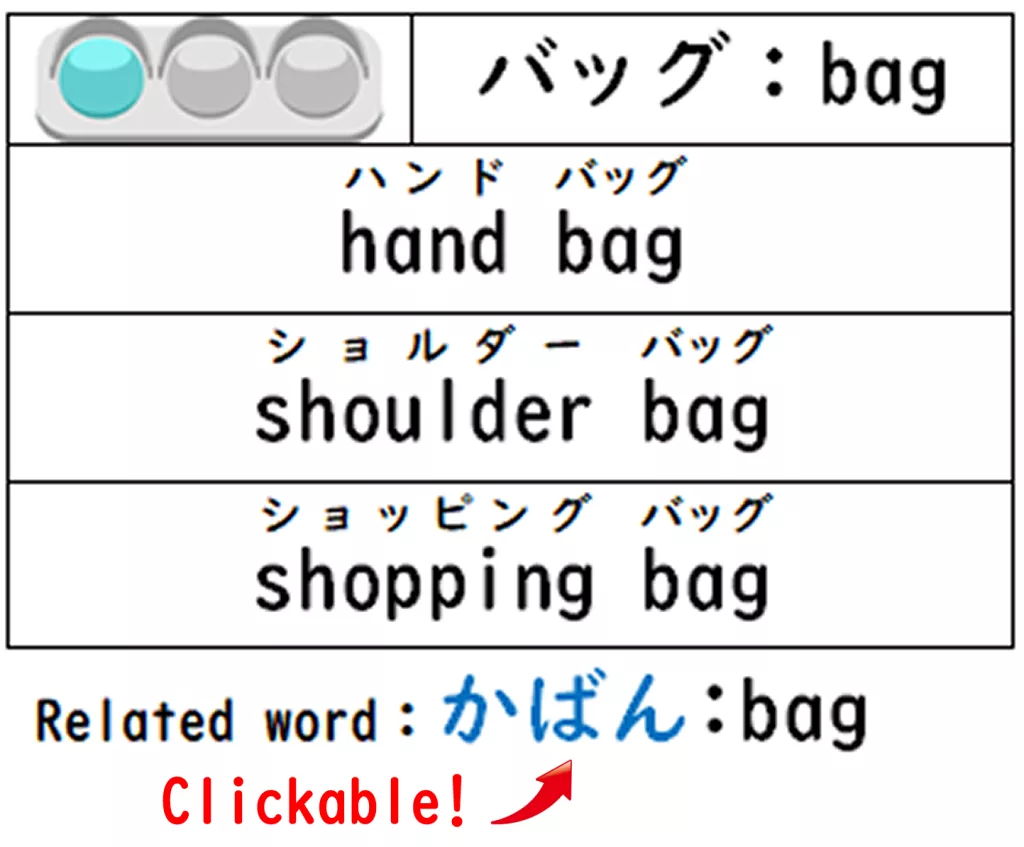Tango [“vocabulary” in Japanese] is a teacher-designed web application for memorising hard-to-memorize Japanese vocabulary.
What is the Goal of Tango?

Tango helps memorizing Japanese vocabulary for English speakers in innovative ways. With the help of puns like “We kissatten at the cafe” to remember the word “きっさてん [café],” the application helps English speakers memorize words through:
Who is it for?

Tango is for “English speakers who want to learn Japanese, especially beginners” who have nothing to rely on when memorizing the arbitrary strings of sounds. It is particularly intended for people struggling to remember Japanese words, and people who are looking for an effective and efficient way of memorizing Japanese vocabulary. Although it was originally created for underachieving students, high-achieving students can also benefit from this method as well.

Tango is also for a person like me who hates students leaving because they cannot remember Japanese vocabulary. Since the creation of TANGO, students have been more successful retaining vocabulary. I see more smiles on their faces, too.
1. Use of puns

The use of puns is at the heart of this website. The target word おてあらい not only uses English words (Oh tell a lie), but is also used in an English sentence that is associated with the meaning of the Japanese word (toilet).
2. Explanations of the word’s anatomy
Some compound words are broken down into their constituent parts showing their anatomy. Understanding a word’s anatomy is an effective way to remember a word, but is challenging if one is not already familiar with those constituent words. In Tango, many compound words are explained using their constituent words with their respective puns.
The words in the table are clickable for further explanations. As you can see below, おてあらい/toilet = [お/prefix] +[てあらい/toilet]. You can click お, if you want to know the further meaning.


Some words provide further explanations of the word. If you can click the second block てあらい, you will see the anatomy explanation for てあらい. [てあらい]=[て/hand]+[あらい/verb stem of あらう/to wash]

Click [て/hand] and [あらう/to wash] for further puns & explanaton.




※ See the sample page for おてあらい
3. Helpful information to memorize the word more easily (grammatical explanations, explanations using kanji, categorical explanations, etc.)
Some words are best learned as a group (e.g. numbers, kinship terms) rather than individually, learned through their construction rule, or learned using kanji.

For example [先週 /last week]、[今週 /this week]、[来週 /next week]、[再来週/the week after next week] etc. are easy to remember if you know the corresponding kanji [先 /previous], [今/present], [来/coming], [再来/next next], [週 /week], [月/month], [年/ year]. Since these words are a combination of the two kanjis, understanding each kanji rather than struggling to remember the long string of sounds is more efficient to remember the words. See how these kanji are combined along with its meaning. In this case, memorising 10 essensial kanjis will enables you to memorise 24 essential words.
For people having difficulties remembering these kanji, Tango provides pun for “先(previous)、今 (present)、来(coming)、再来 (next next),” “毎 (every),” “年 (year)” and “週 (week)、月 (month),” too (of course!) You can also take our Japanese online course which rely on Tango for retaining vocabulary.

-1024x1024.webp)




4. Use of illustrations
Pictures and illustrations are used to help memorize the word or understand the provided pun. Relying on more senses like eyes, ears, and mouth contribute to the better retaining of the words. I (Keiko) created these thousands of illustrations with a strong hope that these will contribute to the students’ efforts to memorise the word.
5. Example sentences

Like many other vocabulary book/sites, Tango also provides example sentences to show how the word can be used in a sentence. Sometimes, the word’s pun is modified and used as an example sentence, which helps remembering the pun as well.
【Example】クールな彼が来ます。
【Meaning】 (My) cool boyfriend is coming.
6. Use of related words
Related word such as synonym, acronym, compounds word that uses the representative word are introduced on the same page. Beginners’ vocabularies are often versatile, which means that it makes many compound words that will come back in different ways as your Japanese advances. Just click the related words in blue which will lead you to the detailed explanation.
【Related words】つれてくる, もってくる, まいります, まいる, かえる,
7. The unique traffic light system
Tango proactively introduces katakana words that are likely to be familiar to Japanese people using the traffic light system. This system employs green, amber and red symbols which indicate the level of familiarity to the Japanese – how likely the word will be understood by the Japanese. These colours are determined according to its appearance on the three major Japanese dictionaries – (1)Kojien (2) Kojirin (3) Koujisen.



Based on the three dictionaries, it also introduces various compound words such as ハンドバック[hand bag]、ショルダーバッグ [sholder bag]、ショッピングバック[shopping bag] for the word バック[bag].
The intention is to lower the hurdle for the beginners who commonly believe that the Japanese is a very different language and thus hard-to-learn. In fact, it is not as much as many believe! When I do the katakana guessing game (read katakana word and guess what it means) with the beginners, many are surprised how much English words are employed in Japanese and realize how much Japanese vocabulary they already know!
